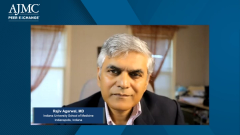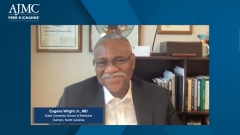
Motivating Patients Who Have CKD and T2DM
Strategies that can help clinicians establish and work toward goals when treating patients with chronic kidney disease to help control disease and prevent progression.
Episodes in this series

Neil B. Minkoff, MD: We’ve talked a little about what you need to do at a high level. You need to control your sugar, control your weight, control your blood pressure, etc. Dr Bakris, you said 133 mm Hg was the high level you want to stay under. How do you stratify these goals? How do you approach these with patients to say what they need to do first, second, third? What are the treatment goals that you’re giving your patients as to where they need to be to prevent the conversation about dialysis, rather than try to get them into being in that survivor class?
George L. Bakris, MD: I set it up as a report card. I say, “You’re back in school. You’re the student, I’m the teacher. We can have conversations, but these are the goals.” I write down what their aspirational level is. Then when the patients come back, I expect them to bring that back and let me know. A lot of them don’t, but they have the data, and then we sit and discuss things. This has been published for the last 2 decades. The hardest thing to get controlled is the sugar. The easiest thing to get controlled is the lipids. Why? You take a statin and you’re done. That covers most of it. Blood pressure is intermediate, a little easier, but still tougher. And then glucose is horrible. Of course, you have to change behavior, change eating habits, and increase your exercise. A lot of these people are in trouble because they never did that. You really have to change lifestyle. That’s tough. I don’t think anybody has a good answer to that, unless the patient is really motivated.
Neil B. Minkoff, MD: I’d like the other clinicians on the panel to weigh in on how they have those same conversations with their patients as well.
Eugene Wright Jr., MD: I like the idea of the report card. In the free clinic, one of the tools we use, that I actually borrowed from a colleague in Texas, is an A1C [glycated hemoglobin] certificate. As people are getting closer to their goal, they get different levels of certificates. You’d be surprised. For many people you see in the free clinic, who’ve never had much success with things in life, to get something that recognizes their work really motivates them to continue. That’s one.
I like the idea of the ABC report card. One of the tools that we use is a publication that’s put out by the ADA [American Diabetes Association] that says the ABCs of your diabetes. It talks about A1C, blood pressure, and cholesterol. In there, there’s a discussion guide for the patient to ask their questions. We start with trying to answer their questions, because many patients get information from many sources that aren’t always reliable. I like to engage them with what they think they know and then build from there. But the idea of having a report card or certificate of improvement is a motivating tool.
Rajiv Agarwal, MD: Neil, those are excellent suggestions, and it reflects the practices of Gene and George. I practice mostly at the VA [Department of Veterans Affairs], and the first thing I have to assess is where I meet the patient and what I need to do to get the buy-in from the patient. It’s very important to understand where the patient is. For example, if I see a patient with a smartphone and I know they’re an accountant or has a college degree, I’m going to shoot at a different level. I might say, “I need you to download this app and scan all your foods for a week, and you will know your sodium intake.” They will ask, “I can do that?” Yes, you can do that, and they’re very successful in doing that. However, if somebody has a flip phone and they’re mowing lawns, I have to send them to a dietitian to get more basic instruction to educate them on a low-sodium diet. I also tell them, “I’m your coach, I can’t play for you. You’re who’s playing the game. I can only tell you what to do, but I can’t do it for you. These are lifestyle modifications that are incredibly difficult to sustain, so you have to be on top of it.”
The third is, how do you motivate people to do it? For example, I just had a patient a couple of weeks ago who’s a snowbird. He goes to Mexico for most of the winter. I was seeing him for the first time and I told him, “You spend your winters in Puerto Vallarta, and I want you to be there and enjoy your grandkids. The only way I can do it is if you take this medication, which will keep you out of the hospital, not short of breath, and prolong your time to dialysis. That reduces your risk.” When you connect the medication with something that fits the patient’s aspiration—he wants to spend his time at the beach and not the hospital—it motivates them to do certain things that you want them to do. You’re meeting them at a place that they want you to come to. Those are important ways to connect with the patient instead of saying, “Here’s a checklist for you. Please follow these.”
Transcript edited for clarity.
Newsletter
Stay ahead of policy, cost, and value—subscribe to AJMC for expert insights at the intersection of clinical care and health economics.






























































